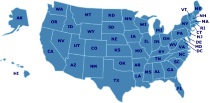Research & Statistics
Resources
The Homeschooling Revolution
Kingdom of Children : Culture and Controversy in the Homeschooling Movement (Princeton Studies in Cultural Sociology)
More than one million American children are schooled by their parents. As their ranks grow, home schoolers are making headlines by winning national spelling bees and excelling at elite universities. The few studies conducted suggest that homeschooled children are academically successful and remarkably well socialized. Yet we still know little about this alternative to one of society's most fundamental institutions. Beyond a vague notion of children reading around the kitchen table, we don't know what home schooling looks like from the inside.
Sociologist Mitchell Stevens goes behind the scenes of the homeschool movement and into the homes and meetings of home schoolers. What he finds are two very different kinds of home education--one rooted in the liberal alternative school movement of the 1960s and 1970s and one stemming from the Christian day school movement of the same era. Stevens explains how this dual history shapes the meaning and practice of home schooling today. In the process, he introduces us to an unlikely mix of parents (including fundamentalist Protestants, pagans, naturalists, and educational radicals) and notes the core values on which they agree: the sanctity of childhood and the primacy of family in the face of a highly competitive, bureaucratized society.
Kingdom of Children aptly places home schoolers within longer traditions of American social activism. It reveals that home schooling is not a random collection of individuals but an elaborate social movement with its own celebrities, networks, and characteristic lifeways. Stevens shows how home schoolers have built their philosophical and religious convictions into the practical structure of the cause, and documents the political consequences of their success at doing so.
Ultimately, the history of home schooling serves as a parable about the organizational strategies of the progressive left and the religious right since the 1960s.Kingdom of Children shows what happens when progressive ideals meet conventional politics, demonstrates the extraordinary political capacity of conservative Protestantism, and explains the subtle ways in which cultural sensibility shapes social movement outcomes more generally.
Research Organizations
Home School Research from HSLDA
Education Resources Information Center (ERIC)
The Home School Researcher
Cato Institute
National Home Education Research Institute (NHERI)
Homeschool Research Analysis
Research Facts on Homeschooling
How Home Schooling Will Change Public Education
Home Schooling in the United States: Trends and Characteristics
Home Schooling and the Question of Socialization
Virtually all homeschooling parents will hear the question at some point ... What about socialization? It is a puzzling question to homeschoolers, as the term itself has various meanings. This well-documented paper by Richard G. Medlin takes a look at this question and concludes that homeschooled children certainly are not isolated. In fact, they associate with and feel close to many types of people. Their socialization skills are very good and they demonstrate good self-esteem, confidence, and resiliency.
Socialization: A Great Reason Not to Go to School
Homeschooling Grows in the Black Community
The Rise of Home Schooling Among African-Americans
Homeschooling Grows Up
Testing the Boundaries of Parental Authority Over Education: The Case of Homeschooling
The Boundaries of Parental Authority: A Response to Rob Reich of Stanford University by Thomas W. Washburne, J.D.
Thomas W. Washburne, J.D. discusses how Reich's ideas for home education have a dangerous implication on the freedoms of homeschooling parents. Let's Stop Aiding and Abetting Academicians' Folly by Larry and Susan Kaseman
Larry and Susan Kaseman discuss the weaknesses in Reich's study and include strategies to counteract negatively biased research on homeschooling.
Home Schooling Achievement
Homeschooling: Back to the Future?
Homeschooling Is Growing Rapidly in Many States of the United States
Homeschooling Growth in the 1980s
Statistics on Public School vs. Homeschool
Homeschooling and Socialization Revisited
U.S. Department of Education Longitudinal Study of 2002: Homeschool Student Questionnaire
The Case for Authentic Assessment
The Case for Homeschooling
Homeschooling in the United States: 2003 Statistical Analysis Report
Research Facts on Homeschooling
NHERI, the National Home Education Research Institute, has compiled these research facts on homeschooling. These fast facts cover the number of homeschooled students, demographics, motivations for home educating, academic performance, social, emotional, and psychological development, socialization, homeschool successes, and general interpretation of research on homeschool success.
Statistics and Data for Oregon and the U.S.
Oregon Home School Data Statistics 2002-2003
Oregon Home School Test Scores by Percentiles 1998-1999
1.1 Million Homeschooled Students in the United States in 2003
The Characteristics of Homeschooled and Nonhomeschooled Students
Oregon Home School Students by Age Level
The Case for Homeschooling
Oregon Home School Students by Age Level 1998-1999
Homeschool Statistics and Achievements
Homeschooling in the United States: 2003 Statistical Analysis Report
Research Facts on Homeschooling
NHERI, the National Home Education Research Institute, has compiled these research facts on homeschooling. These fast facts cover the number of homeschooled students, demographics, motivations for home educating, academic performance, social, emotional, and psychological development, socialization, homeschool successes, and general interpretation of research on homeschool success.
Estimated Number of Homeschooled Students in the United States - 2003
Oregon Home School Data Statistics 2003-2004
Oregon Home School Data Statistics 2000-2001
Sources of Curriculum or Books
Oregon Home School Students Registered by County 1997-1998
Oregon Home School Students Registered by County 1998-1999
Oregon Home School Test Scores by Percentiles 1997-1998
Homeschooling Rates by Student and Family Characteristics
Oregon Home School Data Statistics 1999-2000
Home School Research from HSLDA
Featured Resources
As an Amazon Associate, we earn from qualifying purchases. We get commissions for purchases made through links on this site.





